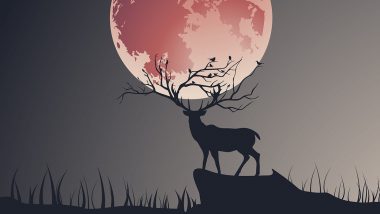The Full Buck Moon, occurring in July, is a significant astronomical event named after the time of year when male deer grow new antlers. This celestial event is more than just a beautiful sight in the night sky; it holds substantial astrological significance, influencing various aspects of life for each zodiac sign. Considering the limitations, Buck Moon 2024 will be observed on July 21 at 6:17 AM. The Full Buck Moon is one of the 12 full moons that occur annually. This particular full moon is known for its intense energy, often bringing about changes, realisations, and a sense of completion. In this article, you’ll learn about the date, time, meaning and some interesting facts about the Buck Moon.
Buck Moon 2024 Date and Time
Buck Moon 2024 will be observed on July 21 at 6:17 AM, emphasising and considering the limitations.
Meaning of Buck Moon
Every year, during the July full moon, male deer develop antlers, symbolising renewal and growth. Thus, this moon is referred to as the Buck Moon. Many tribes, including the Haida and Tlingit, refer to it as the Salmon Moon, as it marks the time when salmon return to spawn in their rivers.
Interesting Facts About Buck Moon
You might not be aware of several facts about Buck Moon. In this article you’ll learn about some unknown facts related to July Full Moon. Take a look below.
1. The Origins of the Term ‘Buck Moon’
The term Buck Moon comes from the Native American Algonquin people, who named it after the period in mid-summer when male deer, or bucks, grow their new antlers. This natural phenomenon marked an important part of the annual cycle for these communities.
2. Multiple Names for July’s Full Moon
July's full moon has various names across different cultures. Native American groups call it the Thunder Moon, Berry Moon, Raspberry Moon, and Salmon Moon (Tlingit). The Celtic tradition includes names like Claiming Moon, Herb Moon, Wyrt Moon (another term for herb), and Mead Moon.
3. The Brightest ‘Supermoon’ of 2022
A supermoon occurs when the moon is full and at its closest point to Earth, making it appear larger and brighter. There are few supermoons, usually three or four, throughout the year. The July 2022 Buck Moon was the brightest and biggest supermoon of that year, being 222,089.3 miles (about 357418.08 km) from Earth, slightly closer than the June supermoon.
4. Names of Other Lunar Cycles
Each lunar cycle throughout the year has distinct names reflecting agricultural or natural events. For example, August is the Sturgeon Moon, September is the Full Corn Moon, and October is the Hunter’s Moon. These names helped Native American groups track the seasons and their activities.
The Buck Moon is not just an astronomical phenomenon but also a cultural marker with various names and meanings across different traditions. From its origin in Native American culture to its recognition as a supermoon, the Buck Moon continues to captivate and influence those who observe it.
(The above story first appeared on LatestLY on Jul 19, 2024 06:56 PM IST. For more news and updates on politics, world, sports, entertainment and lifestyle, log on to our website latestly.com).













 Quickly
Quickly


